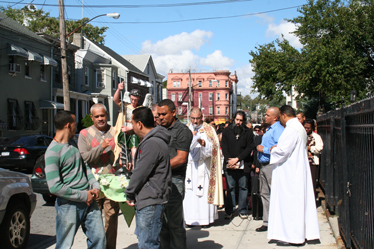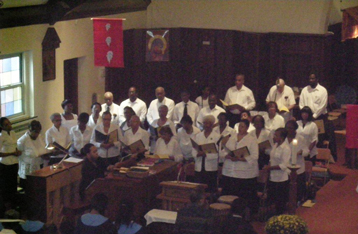by Jay Akasie
This is the first in a special series on the reconfiguration process in the diocese.
Deacon Carlos Garcia likes to think of himself and his wife as a symbol of why parish mergers can work – and work well. Garcia, who grew up serving the East New York parish of St. Michael’s, fell in love with and married a young lady who went to church just three blocks away at St. Malachy’s. “Our marriage was the original test case for the merger of the two parishes,” he says with a smile.
Garcia is joking, of course, but by telling that story he wants people who are anxious about the potential merger of their parish with another one nearby to know they should look upon the event as the beginning of a promising new relationship.

As the Diocese of Brooklyn’s “Christ Jesus Our Hope” reconfiguration plan takes shape, the stories of a handful of parishes across Queens and Brooklyn that have already undergone mergers provide a hopeful message of the sweeping diocesan re-organization.
Today, it’s hard to tell that the parishioners of St. Michael-St. Malachy were embroiled in heated discussions five years ago. When members of both congregations initially learned that they would be merging with the other, there were some tense debates, according to Garcia. “It was really tough at first,” he says. “A parish is a kind of a home, and nobody wants to see his home shut down.”
During the first six months of the merger, after the St. Malachy’s site was being shuttered, the newly combined parish was a merged entity in name only. There were two rectories, two office staffs, and two disparate groups of congregants who were known to have minor squabbles over who sat in which pew. But as the merger progressed, certain aspects of the merger’s efficiencies became apparent.
“Once we got over the pain of the old St. Malachy’s being closed, we all realized that this process wasn’t about us – it’s about Christ. When that started to happen, we put the self-centered emotions behind us and we flourished as a new community of faith,” says Garcia.
As difficult as it is to imagine today, not more than a century ago, most of East New York was little more than a village of freestanding wooden structures populated by German immigrants. The East New York section of Brooklyn had more in common with the agrarian, potato-farming communities of Long Island than it did with the more densely populated urban centers of Brooklyn and Manhattan.
As with much of New York City after World War II, East New York experienced dramatic demographic shifts. The large German-American community whose ancestors had built St. Michael’s had moved almost entirely to the suburbs. In its place arrived large numbers of Puerto Ricans and, later, Dominicans. By 1968, some 200 Spanish-speaking Puerto Ricans were worshipping in the basement of St. Malachy’s because they had yet to feel comfortable assimilating with their English-speaking brethren upstairs.
Today, most of the original Puerto Rican and Dominican families have moved to the suburbs as well. They’ve been replaced by native South Americans and families of Caribbean ancestry.
The story of nearby St. Malachy’s is similar. Except for much of the second half of the 19th century and well into the 20th, that parish catered to Catholics of Irish heritage – not a surprising fact given the name of the parish’s patron saint. When both congregations learned they’d be merging in 2006, Bishop Frank Caggiano, Vicar General of the diocese, reminded them that the families who built both parishes more than 150 years ago were no strangers to tough situations; they had become accustomed to worshipping in parks before they built their respective churches.
In St. Albans
Other parishes didn’t have to choose between which site to shut down. Father Bill Smith was assigned to St. Pascal Baylon in southeast Queens in 2007 when he no sooner heard from the diocese that the parish would be merging with nearby St. Catherine of Sienna. In that merger, both sanctuaries remained open even though the parishes combined into one with the new name of Our Lady of Light.

At first, Father Smith became concerned that low morale was going to be a drag on the reorganization. But he took things in stride and made sure not to let gossip get out of hand.
“I’ve found that there’s always going to be a group of parishioners who are suspicious that all they hold dear is going to be closed down by the diocese,” he says. “They’re completely suspicious of everything. As a pastor, I couldn’t allow that kind of suspicion to be conveyed to the rest of the parish.”
What Father Smith did was to bring as many people on board before and during the merger process so that as many members of the parish took ownership of what they were doing.
“I just kept reminding everyone that we had to keep focusing on the spiritual aspect of the process. That is to say, this was the Holy Spirit working among His people and through his parish. No matter how deaf we tend to be towards those things, we opened our ears to it,” he says.
Initially, it was difficult to see any apparent cost savings at the newly merged Our Lady of Light. But Father Smith says he was blessed with the help of (the recently departed) Msgr. Robert McCourt, who at the time helped him minister to members of both congregations.
Then Father Smith had more time to think about closely monitoring finances. He hired an office manager. “She found savings that I never would have been able to,” he says.
Father Smith interviewed lots of candidates, but chose the one who looked at the job as a project, with an end-date, instead of someone who looked at the job simply as a way to sit back and collect a paycheck well into the future. “We probably didn’t need a finance person for the long haul, but in the short run, we did. That’s when sorting out our finances were so critical,” he says.
Father Smith said the entire real estate portfolio was scrutinized. The two convents associated with the parisheswere rented. Convents, by the their nature, are not income-producing properties. But because they were in good shape and no longer used by nuns, they could be rented out to various neighborhood groups. Plus, because there is now only one rectory, there is a smaller staff to serve it and the utility bills are far less than they were when there were two of everything.
Back at St. Michael-St. Malachy, Deacon Garcia says that strong leadership on the part of all the bishops of the diocese ensured the success of what began as a rocky relationship between the two congregations. These days the combined parish offers more programs and a greater variety of groups and committees than either one of the parishes would have before the merger.
“The people who built St. Michael’s and St. Malachy’s had a vision 150 years ago,” says Garcia. “We need to have that same kind of vision so that Catholics who are living in East New York 150 years from now will know we did the right thing as well.”

2 thoughts on “Christ Jesus Our Hope – Parish Mergers Are Roadmaps to Success (with slide show)”
You must sign in to leave a comment.